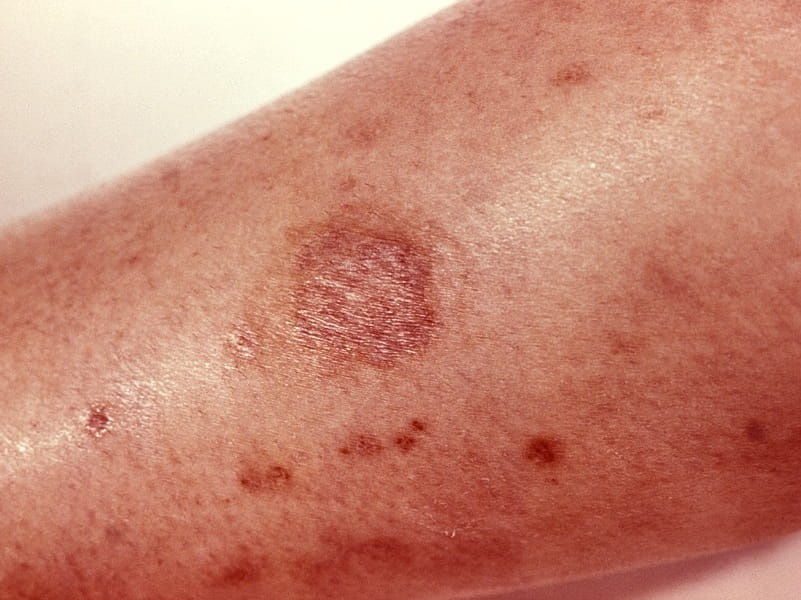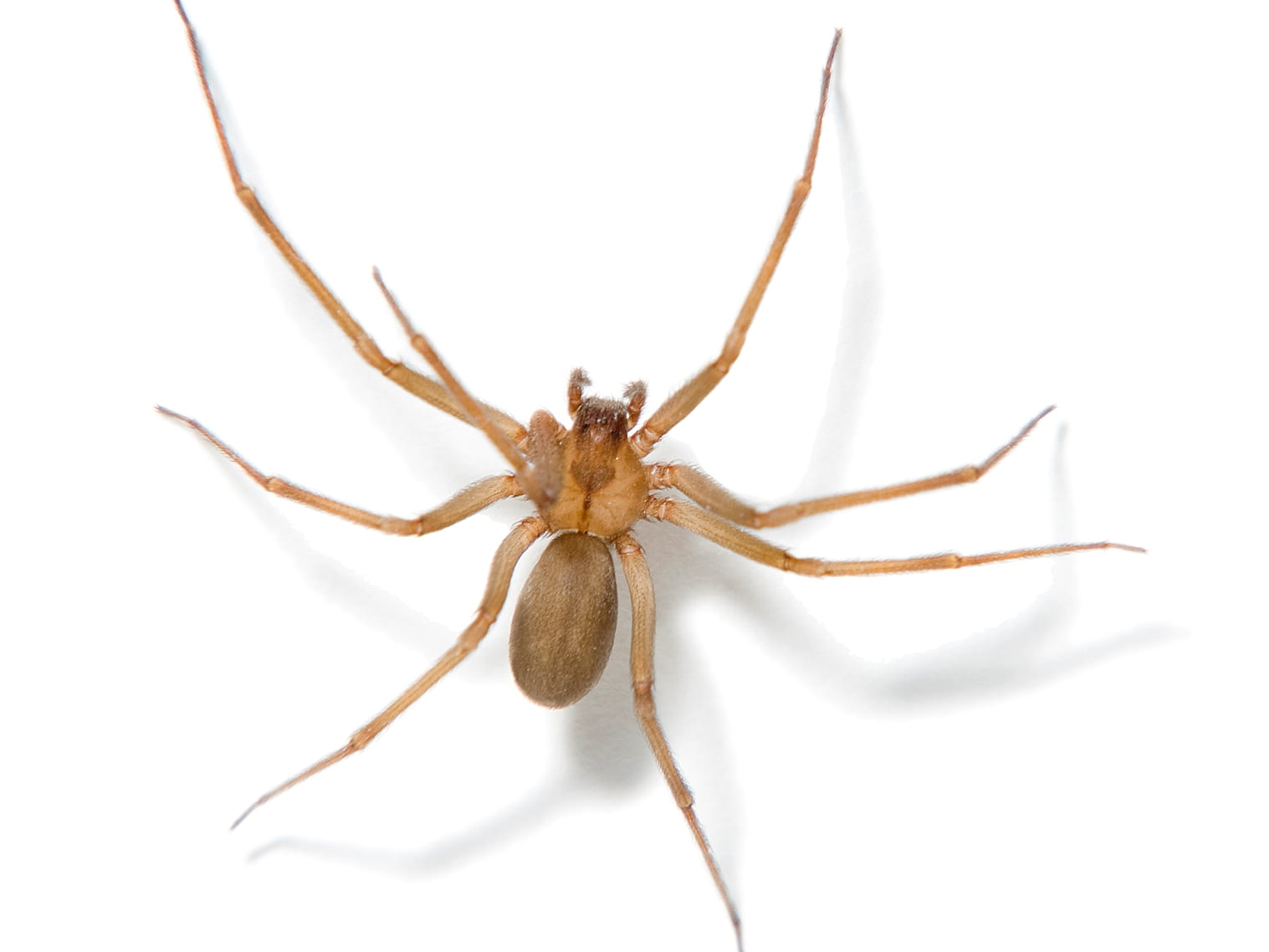Brown Recluse Spider Bites Know the Signs, Reduce the Risks

The Bottom Line
Brown recluse spiders are rarely seen or identified. A brown recluse bite often is not felt when it happens. The complex venom causes injury and death (necrosis) of the surrounding tissues. In severe cases, the venom can damage deeper tissues. Serious illness and death are rare. There is no antidote; treatment includes treating the wound and preventing infection.

The Full Story
Venomous spiders found in the United States include the black widow and the brown recluse. Although reports of bites from a brown spider that caused severe tissue damage and even necrosis (tissue death) can be found as early as 1872 in the United States, it was not until 1957 that the brown recluse spider, Loxosceles reclusa, was identified as the likely culprit. Today, the brown recluse spider is one of the most medically important spiders. Of the many thousands of spiders we come across, it is one of the few that not only can bite humans, but whose venom can cause serious wounds and poisoning.
What does a brown recluse spider look like?
The brown recluse spider is recognized by the unique violin-shaped marking on its back, with the neck of the violin pointing towards the rear of the body. As its name suggests, the spider is tan to brown in color. The violin-shaped marking is a darker brown. There are no other markings, such as stripes or bands, on the rest of its body or legs. Although the violin-shaped marking is easy to identify, the most unique feature of the brown recluse spider is its eyes. While most spiders have eight eyes, the brown recluse has six eyes arranged in three pairs in a semi-circular row.
How big is a brown recluse spider?
An adult recluse can be as big as a United States quarter, including its legs.
Where does the brown recluse spider live?
Within the Loxoceles family of spiders, the brown recluse is the most widespread in the United States and is commonly found in Southern and Midwestern states.
The name "reclusa" describes the spider’s behavior – it avoids humans and human activity, lives in dark and quiet places, such as basements and woodpiles, is active at night, hides its web and is rarely seen. Even though it avoids humans, it bites when threatened. This usually happens when a previously dark and quiet place – like the garden gloves or boots you had stored in your garage – is suddenly disturbed when you put them on.
What does a brown recluse spider bite look like?
The victim may not feel or notice a brown recluse spider bite when it occurs. At first, the bite site may appear like any other insect bite - a little red, itchy, and inflamed. Over the course of a few days, severe symptoms may develop as the venom destroys the surrounding tissues, and a blister may form. The wound may get larger, more painful, and darker in color. Necrosis or tissue death is identified when the tissue develops an ulcer, becomes black in color, and forms a crust that eventually falls off. The venom can penetrate deeper in the tissues, sometimes affecting the fat and muscles. The wound can quickly and easily allow an infection to set in, worsening the wound-healing process. The infection as well as the venom can also spread to the rest of the body and possibly become life-threatening. Often, the bite of a brown recluse spider leaves a crater-like scar, even after it has healed completely. In addition to the wound, a brown recluse bite victim may develop a fever, chills, and nausea.
It is very difficult to diagnose a brown recluse bite unless the victim felt the bite and saw and correctly identified the culprit. Many other conditions can mimic the bite of a brown recluse spider: bacterial, viral or fungal infections; other insect bites; and medical conditions that affect blood circulation. An educated guess can often be made based on a careful history obtained from the patient.
How to treat a brown recluse spider bite.
There is no antidote for the brown recluse venom. Treatment is targeted towards specific symptoms.
- Avoid touching or scratching the bite.
- Clean the bite area with soap and water.
- Apply a fresh, non-stick bandage to the bite area.
- Antihistamines can be given to relieve itching.
- Antibiotics prevent or treat infection.
- Surgical intervention may be needed for deep or infected wounds.
- Tetanus vaccinations must be up-to-date. A booster is usually given if the person’s vaccine status is unknown.
What to do if you are bitten by a brown recluse spider.
If you suspect a brown recluse spider bite, wash the bite area with soap and water. Then call Poison Control at 1-800-222-1222 or use webPOISONCONTROL® to get help online. The nurse or pharmacist who answers your call will tell you what to do. If you need emergency care, the poison specialist will contact the emergency room staff with treatment advice.
Serkalem Mekonnen, RN, BSN, MPH
Certified Specialist in Poison Information
Poisoned?
Call 1-800-222-1222 or
Prevention Tips
- Shake out items such as gloves, boots, shoes, clothing and blankets before using them, especially if they are not used often or have been in storage.
- Warn the spiders by making noise or vibrations (i.e. stomping your feet) before entering basements, attics, storage areas and unused closets.
- Avoid clutter. Brown recluse spiders love to hide in the nooks and crannies of your home, or in between or under items.
- Glue traps can be useful.
- Contact a professional pest control operator if you suspect an infestation of brown recluse spiders within your home.
This Really Happened
A 30-year-old man went to his doctor's office because of a possible insect bite on his hip. He had noticed the bite a few days before. The bite site had since begun to look worse. The surrounding skin had become much darker in color and a small part of it had turned black.
Four days prior, the patient had seen what he thought was a brown recluse spider that may have bitten him. The doctor also suspected a brown recluse spider bite and called Poison Control for treatment advice.
The wound appeared to be infected. Both intravenous (IV) and oral antibiotics were given. Because the wound was deep and surrounded by blackened, dead tissue, debridement by a surgeon was required. Debridement is a procedure in which a doctor removes unhealthy tissue - dead, damaged or infected - in order to help the remaining healthy tissue heal properly.
The patient responded to the antibiotics and the infection cleared up. Two weeks after the bite, the wound was beginning to heal and healthy tissue was forming.
For More Information
Centers for Disease Control and Prevention - Venomous Spiders in the United States
Black Widow Spiders (The Poison Post®)
References
Juckett G. Arthropod bites. Am Fam Physician. 2013;88:841-847.
Poisoned?
Call 1-800-222-1222 or
Prevention Tips
- Shake out items such as gloves, boots, shoes, clothing and blankets before using them, especially if they are not used often or have been in storage.
- Warn the spiders by making noise or vibrations (i.e. stomping your feet) before entering basements, attics, storage areas and unused closets.
- Avoid clutter. Brown recluse spiders love to hide in the nooks and crannies of your home, or in between or under items.
- Glue traps can be useful.
- Contact a professional pest control operator if you suspect an infestation of brown recluse spiders within your home.
This Really Happened
A 30-year-old man went to his doctor's office because of a possible insect bite on his hip. He had noticed the bite a few days before. The bite site had since begun to look worse. The surrounding skin had become much darker in color and a small part of it had turned black.
Four days prior, the patient had seen what he thought was a brown recluse spider that may have bitten him. The doctor also suspected a brown recluse spider bite and called Poison Control for treatment advice.
The wound appeared to be infected. Both intravenous (IV) and oral antibiotics were given. Because the wound was deep and surrounded by blackened, dead tissue, debridement by a surgeon was required. Debridement is a procedure in which a doctor removes unhealthy tissue - dead, damaged or infected - in order to help the remaining healthy tissue heal properly.
The patient responded to the antibiotics and the infection cleared up. Two weeks after the bite, the wound was beginning to heal and healthy tissue was forming.
